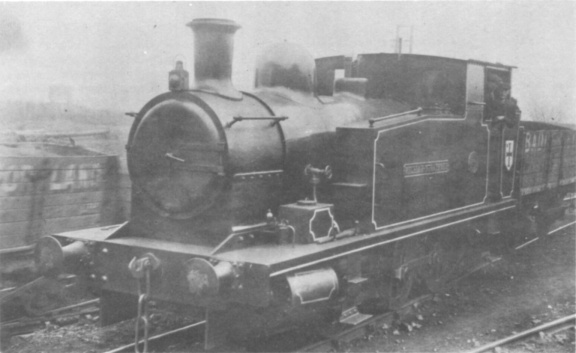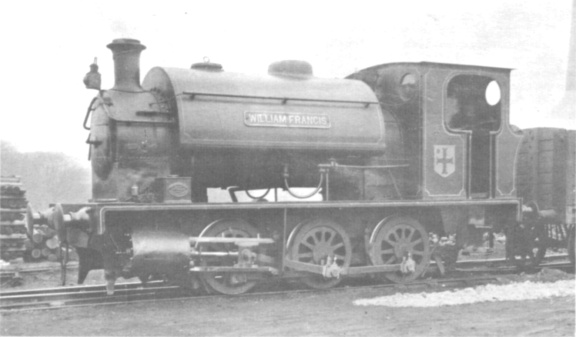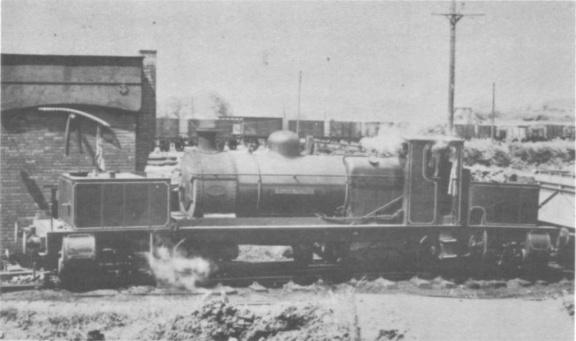
WILLIAM FRANCIS
ROGER E. WEST

| THE INDUSTRIAL RAILWAY RECORD |
© SEPTEMBER 1966 |
|
|
WILLIAM FRANCIS
ROGER E. WEST |
|
The Baddesley Colliery at Atherstone in Warwickshire is well known to most industrial locomotive enthusiasts as the home of WILLIAM FRANCIS, one of the few Beyer-Garratt locomotives in industrial service in this country. Few of them, possibly, have explored the line to Atherstone Sidings and Wharf on which the engine works, merely realising that there must be some hard work to be done somewhere, Soon, apparently, the Garratt will run no more and although this article is not intended as a full history of Baddesley colliery some notes concerning the line and its locomotives, and in particular WILLIAM FRANCIS, may be of interest.
> Coal has been mined in the area of the present Baddesley colliery for centuries past, the coal being gained initially from open pits or adits in the surrounding fields as early as the fifteenth century; some fields still bear such names as Colepit Fields. Larger pits existed in the nineteenth century and in 1848 Baddesley had three - Maypole Pit (the remains of the shaft are still to be seen near the Maypole Inn), Hene Pit and New Church Pit. The present colliery was sunk in the latter part of the century - about 1876 - to replace these. The colliery was founded by William Stratford Dugdale, a member of the prominent local family, who incidentally lost his life in May 1882 while assisting in rescue operations after an underground disaster at the pit. The ownership was in the hands of the Trustees of the Baddesley Colliery until in June 1926, Baddesley Collieries Limited was formed: on 1st January 1947, of course., the company was nationalized to become part of the National Coal Board, West Midland Division.
There appears to have been a tramway between Baddesley and the main LNWR West Coast main line from about 1871, for sidings were laid at the present site under an agreement between the Trustees and the LNWR, dated 8th July 1871. However, the line also serves the Coventry Canal, a considerably older form of transport, and it could be that the tramway was originally built to serve this canal and is older than 1871. The line appears to have run on much the same route as the present one for the most part, but diverging across Baxterley Common to the earlier pits located in that area. The latter part of that route was partially in a tunnel - the remains of this too can still be seen. Horses and gravity may have been used to work the tramway, but cable haulage seems the more likely. Presumably when the new pit was opened in 1876, this old line gave way to the new one on the route as we know it today, although since 1885 is the date of the first recorded locomotive, this later date may be nearer the truth, the locomotive being contemporary with "modernisation" of the workings and the new pit meanwhile feeding on to the existing line. The history of this phase seems obscure and the fact that the Midland Railway branch from Kingsbury Junction (on the Tamworth - Water Orton line) was opened on 28th February 1878 only leads to more conjecture about the actual facts. From at least 1885, though, it can be assumed that the line was basically as it is today, that is, a steeply graded track linking the colliery with the main line and the canal at a point about three quarters of a mile north of Atherstone Station, together with a connection within the colliery yards to the MR branch previously mentioned.
It is interesting to note the position of this MR branch in relation to the same Company’s branch from Stockingford (on the Nuneaton - Birmingham line) to Ansley Hall Colliery. With the termini being less than two miles apart and at similarly high levels, it was no doubt the intention to link the two and form a through route. The fact that the Ansley Hall branch terminates in the middle of a field with a trailing connection into the colliery yard - the colliery itself having been passed about half a mile back - lends weight to this supposition.
Baddesley Colliery itself is actually in Baxterley village about two miles north-west of Atherstone. From the West Coast main line in the Trent Valley, the tramway rises from about 260ft above sea level to just on the 500ft contour in a distance of about a hundred yards short of two miles - an average gradient of 1 in 47. Despite the fact that the tramway exists as a means of sending coal away from the colliery, the main interest in any hill climb is the ascent and a description of the route is probably best taken from the lower end.
From the exchange sidings with British Rail, the line runs southwards, quickly turning west in a large curve, and falling slightly until it reaches the crossing with the A.5 trunk road. The canal wharf sidings trail in here, immediately before the crossing. The "narrow" Coventry Canal passes the end of these lines and further north runs under the BR tracks on its way northwards. Between the angle formed by the wharf and the main line connection is a canal basin along one side of which runs one of the rail sidings. The canal traffic in coal must at one time have been a very considerable proportion of the output (twenty to thirty boats a day were handled) the coal being loaded into boats manually, using portable chutes to bridge the gap between the wagons and the vessel. It must have been quite an animated sight with steam- and horse-drawn boats crammed into the basin, each with its traditional gaily painted living quarters. Nowadays, of course, this traffic has all but ceased, although the occasional boat is still dealt with, filled by lorry running direct from the colliery. The basin is now a sorry sight, half-filled with coal, half-choked with weeds and a derelict boat lying almost submerged. The extensive stables for the horses, now derelict but still recognisable, serve as reminders of a once very competitive means of transport in the colliery districts of the West Midlands. The remaining sidings at the wharf serve local coal merchants.
Leaving the wharf sidings, the line immediately crosses the A.5. This crossing must be one of the few remaining tramway crossings on a trunk road: on either side is a fast, straight, four-lane carriageway and the job of stopping high-speed traffic on this busy road is a sore point with the crossing keepers and not an enviable task in foggy weather or when it is necessary to work after dark in winter. No gates are provided (except to prevent access to NCB property) or signals - only the usual "Crossing No Gates" signs. The potential danger of the crossing and consequent pressure from the County Council has caused thoughts of abandoning the line and relying on the MR link from the colliery, but opinion is that the pit would not work properly in such a manner.
|
|
|
|
|
PRINCIPAL DIMENSIONS Driving wheels 3ft 4in ....................................Cylinders 13½in by 20in Tractive effort 24,600lbs .................................Bogie wheelbase 5ft 6in Bogie pivot centres 22ft 6in .........................Working pressure 180lbs Firebox heating surface 107 sq ft.........Total heating surface 1406 sq ft Boiler length 9ft 6in ....................................Front ring diameter 5ft 0in Tube diameter 1¾in ...........................................Number of tubes 288 Water capacity front 950 gallons .....................and at rear 550 gallons Coal capacity 12 tons .....................Weight in working order 61½ tons |
One of the features of the line is the unusual - for industrial tramways - presence of gradient posts, although there appears to be an incomplete set. From the level crossing the line continues west and runs into reception sidings at progressive gradients of 1 in 94 and 1 in 39. At the end of these sidings it starts climbing in earnest at 1 in 32, first in a shallow, then a deeper, tree-lined cutting about half a mile long. Towards the end of the cutting the grade lessens to 1 in 45 and 1 in 82 before the line turns south-west to run parallel to a minor road and through a picturesque group of trees. From a distance a platelayers hut looks at first glance very similar to a light railway wayside station. After some five hundred yards of this relative "flat" the ascent continues at 1 in 35, with the line being level with the surrounding fields here. The last few hundred yards approaching the colliery tip are through another shallow tree-lined cutting at 1 in 30, and then under the shadow of the tip the line opens out into four reception sidings. The "main line" continues under a minor road and then climbs at its steepest grade - 1 in 23 - through the colliery yards to the sidings at the top end of the colliery premises, on the way receiving a trailing connection from the MIR branch. The outgoing full wagons from under the screens are run into sidings parallel to the latter, and then taken back on to the tramway at the top end of the yard. This layout is comparatively recent, the colliery washery, screens and yard having been remodelled in the late 1950’s. A spur climbs back from the final sidings through the workshop buildings to the locomotive shed and NCB wagon repair sidings (internal wagons from Kingsbury and Birch Coppice are repaired here). it is this last piece of climbing that results in the line reaching a height of 500ft. The whole of the track is bullhead rail laid mainly with second-hand LMS chairs and apparently similar sleepers - one example bearing a plate "Track Circuit No.X"! - on ash or dust ballast but maintained in fairly good order.
With the steepness of the gradient the trains are always worked with the locomotive pushing the wagons up the grade and running before them on the way down. Working up the track a lookout man travels in the front wagon to watch out for obstructions and to warn the driver if necessary. In recent times leaking steam on WILLIAM FRANCIS has made forward vision difficult, and a further man has been carried in front of the smokebox. Today the maximum load taken. by WILLIAM FRANCIS is eighteen standard 16−ton mineral wagons, the Austerity locomotive being capable of sixteen. At one time some miners used the trains to get to and from their work. This appears to have been "unofficial" as travel was in the coal wagons, presumably by any convenient trip, although the line did acquire the nickname of "the Paddy Line" - a not unusual thing for a colliery line. The practice appears to have been stopped some time before the Second World War.
WILLIAM FRANCIS, built in 1937, Beyer Peacock works number 6841, named after Sir William Francis Dugdale, the son of the founder of the colliery, was the third locomotive at Baddesley to be so bestowed. In appearance this locomotive was virtually identical to the other three Garratt locomotives supplied by Beyer Peacock for industrial service in this country, but suffered the economy of steel boiler bands and dome cover instead of brass ones on the earlier examples. The design is a genuine Garratt, the relatively small size not precluding the full use of the basic principles of the type. Now the locomotive is nearly worn out - all the more pity because in 1956 it was returned to the makers for general overhaul. For some reason enthusiasts in Canada have taken an interest in WILLIAM FRANCIS and arrangements have apparently been made to ship the engine across the Atlantic in due course. It seems regrettable that the engine could not be preserved here, since no full size Beyer-Garratt will be left in this the country of its development.
Brief mention perhaps may be made of the other locomotives which have worked at Baddesley. As mentioned previously, locomotive haulage was introduced in 1885 with the appearance of an 0−4−0 saddle tank (Hunslet No.358). This locomotive was named WILLIAM FRANCIS - so starting the tradition of naming the locomotives after members of the Dugdale family - and had 13in by 18in outside cylinders and 3ft 4in driving wheels. Its subsequent fate is unknown but it was advertised for sale by the Trustees in June 1900. A second engine was ordered from Hunslet in February 1898 and later in the year they delivered No.683, STRATFORD, a slightly larger 0−4−0 saddle tank with 14in by 18in cylinders and 3ft 5in driving wheels. STRATFORD would refer to William Stratford Dugdale, the founder; the engine was later named EDGAR and appears to have been scrapped by about 1934. Soon after STRATFORD arrived a third locomotive was acquired, this time a rather neat example by Kerr Stuart, their No.682 (by a coincidence one number less than the previous engine). An 0−6−0 saddle tank with 14in by 20in outside cylinders, it was delivered at Atherstone Sidings on 8th January 1901. Once again the name WILLIAM FRANCIS was used, and possibly the locomotive replaced the original WILLIAM FRANCIS and took its nameplates. Kerr Stuart 682 was scrapped in 1937, and the name passed on yet again to the Garratt. In 1916 Manning Wardle delivered a large 0−6−0 saddle tank, No.1891, with 16in by 24in outside cylinders and named MEREVALE, the name of the home of the Dugdale family; this large locomotive must have been more suited to the tramway than the previous locomotives. A further locomotive builder supplied the penultimate engine in 1923, Andrew Barclay No.1799 being a large 0−6−0 saddle tank of rather severe outline. The name BADDESLEY needs no explanation. The latter two locomotives were subsequently renamed, when it appears that naming after members of the family was again favoured. MEREVALE became JOHN ROBERT (after John Robert Stratford Dugdale - younger grandson of the founder) and BADDESLEY became WILLIAM STRATFORD (after William Stratford Dugdale, the elder grandson). The later livery of Baddesley Collieries Ltd. appears to have been black, lined white, with the Dugdale crest - a red cross on a white shield - appearing on the cabside. WILLIAM FRANCIS, even now, is painted royal blue (almost weathered to black), lined white and red on cab and bunker.

WILLIAM STRATFORD - Andrew Barclay 1799 of 1923 (Author’s Collection).

The second WILLIAM FRANCIS - Kerr Stuart No.682 (Whitworth Collection).

The third WILLIAM FRANCIS, in 1953 (F. Jones).
* * *
WILLIAM FRANCIS remains the sole member of the pre-nationalisation stock, aided at present by WARWICKSHIRE, a standard Austerity type by Robert Stephenson & Hawthorn (No.7752 of 1953) which came from Birch Coppice Colliery in February 1957, and BADDESLEY No.1, another Austerity (Hunslet 2859 of 1943) which first appeared at Baddesley in 1948. The latter‘s name, which was of course bestowed at Baddesley, is not now carried. Both Austerities have been subjected to experiments, in the hope of increasing efficiency on the haul from Atherstone. In June 1959 BADDESLEY was fitted with a Giesel ejector (in place of the usual chimney) and was one of the first British locomotives to be so fitted. During a rebuild by Bagnall at Stafford in 1961, WARWICKSHIRE acquired an automatic stoker, a seemingly useful fitting which failed to come up to expectations as it was removed by 1963 and dumped in the shed. (The drivers told us in July 1962 that the diesel generator powering the underfeed stoker made a "heck of a row and racket" and they preferred not to use it at night if another locomotive was available. - Hon. Eds.) WARWICKSHIRE worked at Kingsbury Colliery for a time during 1962, and AMINGTON No.2, a Hawthorn Leslie 0−6−0 saddle tank came from there to Baddesley on loan during 1964 for a similar period. AMINGTON No.3, a large Bagnall 0−6−0 saddle tank (2508 of 1934) came to Baddesley in September 1955 and later spent considerable time as a stationary boiler underneath a gigantic chimney extension; afterwards it gradually rusted into a deplorable condition in the back of the shed, being withdrawn in July 1964 and cut up soon after, Of the original Baddesley locomotives WILLIAM STRATFORD had many wanderings - a spell at Kingsbury Colliery during 1953, a very short one on loan to Coventry Colliery in October 1958 and again early in 1959. From Coventry it went on to Arley Colliery in October 1962, where it was sold for scrap to Cashmore of Great Bridge in January 1965. JOHN ROBERT fared better, being sent to Birch Coppice in September 1962 (after overhaul at Ansley Shops).
In conclusion, for their help in providing information contained in this article I should like to thank Mr Allan Leach, Regional librarian at Atherstone Library and the Public Relations and Publicity Officer, British Rail, London Midland Region.